
surfresearch.com.au
newspapers : 1965
newspapers : 1965
| home | catalogue | history | references | appendix |
 |
surfresearch.com.au
newspapers : 1965 |
|
|
|
|
|
| CRESCENT
HEAD, 300 miles north of Sydney, is the
greatest," said Bill, 22, who's known as
"Wet Pretzel" Wetzel in the surfing
world. "The waves I found there a few weeks back were worth the 8000-mile trip from California. "I've struck a few nice waves in Sydney at Fairy Bower and Manly, but one look at Crescent and I was hooked. "Crescent is a Rincon (California's top surfing spot) with warm water," he said. "We surf at Rincon in water temperatures as low as 40 and 50 degrees, while Crescent was around 75 degrees when we were there at the end of February. "It's not the quantity but the quality that makes the perfect wave, and, oh boy, Crescent sure has quality. "It's a smooth, steep take-off directly off the rocks at the point and then turns into a vertical wall which permits weightless type of riding - perfect for all hot dogging (trick-riding) techniques. "And, what's more, it's a right slide wave breaking and rolling to beach to the right), which is ideal for me .- the 'goofy-foot' rider," Bill said. |
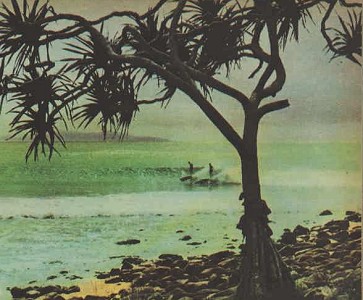 A
view of Crescent Head, one of
Australia's
most popular surfing spots, 300 miles north of Sydney. |
| Bill
thinks Australian riders have improved
"200 percent" since he first surfed with
some of them in Hawaii two years ago. "I must admit I wasn't greatly impressed at that stage, but now their styles and techniques are just as good as Californian and Hawaiian riders," he said."There aren't as many femlins (girl riders) in Australia as in California, but I've seen some good ones." Bill, who usually spends his winters skiing in Snow Valley, California, hopes to get a job this winter and live in the snow country. But at present he's busy trying out Australian surf, making boards, and writing his first novel. "It's fiction based on the many colorful surfing personalities I've met around the world," he said. "It's all about surf fever - that mysterious 'bug' all surfers seem to catch as soon as they take up boardriding. "My book's a philosophy on why everything else becomes second place to surfing," Bill said. "But don't ask me why now, because it'll take a novel to explain it.'* |
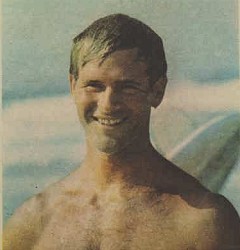 CALIFORNIAN
surfer Bill Wetzel,
who has found the perfect wave at Crescent Head |
|
JUST
GIVE NAT THE
SIMPLE SURFARI
LIFE
By KERRY YATES
[Teenagers Weekly]
The
red-carpet treatment for surfers
in Peru - from a luxurious clubhouse
to the boys employed to wax and
carry members' boards
to the
water-didn't impress top Sydney board-rider
Robert ("Nat") Young.
BOARD-RIDING is more a social symbol than a sport in Peru," said Nat. "It costs about 1000 dollars (about £A500) a year to join the exclusive Waikiki Board Club there. 'There are very few teenage board-riders. Most are around 25, because the young ones just can't afford to keep up with Peru's select 'surfie society.' Surfboards which cost about £45 in Australia sell for as much as 300 dollars, about £150)," said Nat. "In fact, I sold one of mine for £190 when I was there." The red-carpet treatment for surfers in Peru - from a luxurious clubhouse to the boys employed to wax and carry members' boards to the water- didn't impress top Sydney board-rider Robert ("Nat") Young. |
 Nat
surrounded by some of the trophies
he has won. He bought the llama-skin rug in Peru, where he recently won a world surfing title and was runner-up in another. |
| When he visited California Nat noticed the latest
craze with
American teenagers was the skate board - a
miniature surfboard on
wheels. When he returned to Australia, he and two friends formed a company and started the craze here. "In no time we had 17 people working for us. and were selling hundreds a week," said Nat. "I sold my partnership in the company just before I went to Peru." Designing
And since he returned to Sydney Nat has been designing equipment- from board shorts to a surfboard for manufacturing companies. He's also been modelling surfing fashions and has made personal appearances in some of Sydney's leading department stores. Next month Nat, who's already appeared in several Australian and American surfing movies ( including The Endless Summer, Surfing the Southern Cross, and The Young Wave Hunters), plans a trip to South Australia with Sydney film producer Bob Evans. "We want a surfing trip along the Great Australian Blight, with Bob shooting scenes of me riding waves for his new movie," said Nat. |
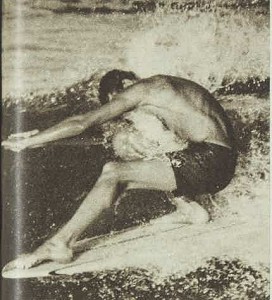 Sydney surfer
Nat Young
shows the style that has made him a world surfboard champion. |
| BOARD-RIDER Paul
Witzig had talked my husband,
Ron Taylor, into joining him in
Queensland at Noosa Heads, where
he himself was shooting film. The agreement was that he could photograph Ron's skindivers and we could photograph Paul's board riders. It had sounded good in theory, but now I was beginning to have my doubts. "Surfing types are dreadful rowdies," warned one friend knowingly, "and their language is frightful." My feeble reply that I had always found surfboard riders very nice fell on deaf ears. "They are all the same," warned my aunt. "You'll be run out of town." By the time we drove out of Sydney I was feeling like Daniel about to enter the lions' den. We had Tanya Binning with us, and John Harding, our diver, met us in Queensland. Noosa, one of the most charming places I have ever been to, is about 100 miles north of Brisbane. The boys, to my surprise, had not yet been run out of town but were living in a rambling old house overlooking the beach. Prepared for the worst, I dodged into the kitchen. It was remarkably clean, and the fridge contained only butter and milk, not the gallons of strong liquor I had been led to expect. It was almost disappointing. |
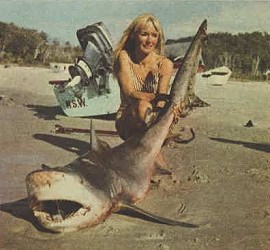
VALERIE HEIGHES
(a champion Australian spear fisher) with a whaler shark. Behind her, the outboard called Eva. |
Page 21 (Point) Lookout on Stradbroke Island. The next day we travelled another 30 miles to Flinders Reef, off the northern tip of Moreton Island, and there, to our relief, the water was clear. Now that my chance had come to prove my worth, I had the flu - these things always happen to me- but my moment of glory was yet to be. The board-riders took to spearfishing. Robert borrowed my gun and promptly speared a 71b. fish, and Russell caught a lobster. Kevan, who, the night before, had listened to Rodney Fox tell about his shark attack, was not so brave. He went spearfishing with only his head in the water, the rest of him high and dry on a surfboard. Rodney had joined us the day before. |
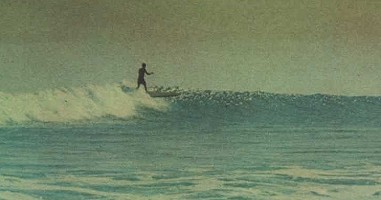 THE WAVE
begins to break far out at
sea,
and Kevan Brennan has caught it. This coast, 30 miles from Noosa Heads, has no road; few surfers know it. |
|
"My
moment"
My moment of glory had come, for Ron called out to me to bring the powerhead gun over - he wanted to photograph me killing the shark with an explosive tipped spear. I cast the blankets aside and, gun in hand, went to act out my part. The shark, like all sharks, was uncooperative, and moved into 50ft. of water, where it was joined by two others. Down went Ron, his camera whirring Down went Valerie, sick and feverish, but a few seconds later my shark was dead on the ocean floor. Thank heavens for that shark! The boys were impressed with me, and the film shots came out well. Shooting
that perfect
wave in
Queensland are
Robert Conneeley
and, nearest the
camera, Russell
Hughes.
The trip was nearly over. Ron had enough footage. I felt sad at leaving my board-rider boys. They had been really wonderful, washing dishes, running messages or doing anything else to help. I had heard no swearing; their main drink was Ovaltine; they were clean, tidy, and full of fun. And so, might I add, were many of their friends whom we met while making our film. WARMING-UP RUN
for Robert, Russell, and
17-year old Kevan Brennan,
who is the New South Wales
junior and senior board-riding champion. The day was sunny, but the sea wasn't warm. Pictures by Valerie Heighes. |
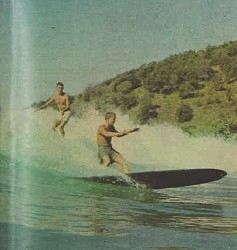 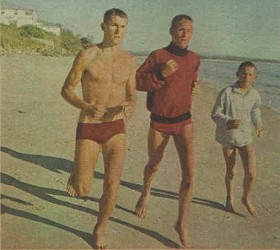 |
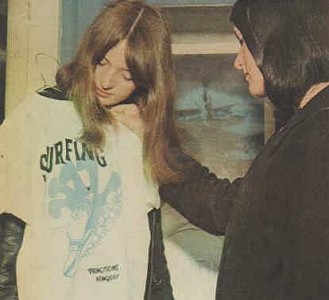 |
"SURFIES" OF CORNWALL
From KERRY McGLYNN, in London TRYING A
T-SHIRT for size in the Surf
Centre
at Newquay, Cornwall, is Shirley Lewis, 18, with her friend Sue Giblin, 17, down on holiday from Manchester. AT RIGHT: Bob Newton, one of the Australians at Newquay, checks Malibu boards for hire on the beach.
Bob,
from Balgowlah,
N.S.W., has spent
the summer as a lifeguard. |
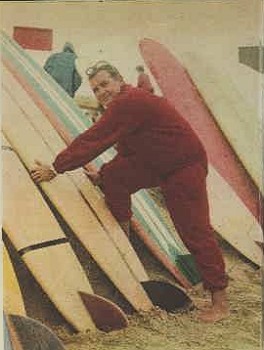 |
|
On the crowded
beaches at Casablanca,
Naples, Biarritz, and Marseilles
the sleek fibreglass
boards that dominate Australian
surfing are taking a
magical grip, and many of them
are made at Newquay.
From his luxury
villa in Sardinia,
where he recently entertained
Princess Margaret and Lord
Snowdon, he has sent a
message to two surfboard
champions from Australia that
he wants to try his hand at the
Malibu madness.
His instructors
will be Sydney boardriders
Rodney Sumpter, 18, of
Avalon, and 23-year-old
Dennis White, of Collaroy.
BOB HEAD, from
Newport, N.S.W., works on a
surfboard.
He set up the factory and shop at Newquay with three English partners and sells Malibu boards in England and on the Continent for well under half the price of the boards imported from America. |
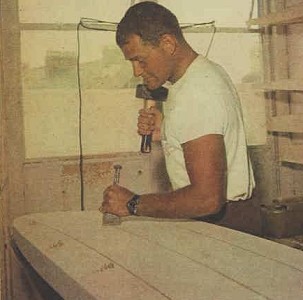 |
| Head
rates the Newquay surf the best in
Europe "on its day." "The difference," he said, "is that in Sydney you can surf for maybe two-thirds of the year. "Here you are lucky to surf for even a third of the year." Head is the "elder statesman" - certainly the longest-established member of the 15-strong Australian surfing community who live in Newquay. Five of these Sydney surf fanatics, Bob ("Nuts") Newton, 26, of Balgowlah, Gary ("Lumpy") Cox, 23, of Har- bord, Warren ("Sui") Sullivan, 27, of Warriewood, Noel ("Yokum" ) Harridine, 28, a former captain of Warriewood Surf Club, and Mick ("The Phantom") Irwin, 25, of Harbord, work as £14-a-week lifeguards on the beaches around New quay. In
caravans
At nights they serve in a local pub pulling beer. |
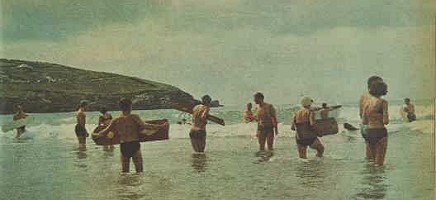 AN END-OFSUMMER DAY at Newquay, and it looks like rain, but enthusiasts are in the surf with several kinds of board. Board riding caught on rapidly during the season which has just ended. |
|
|
|
|
|

| home | catalogue | history | references | appendix |